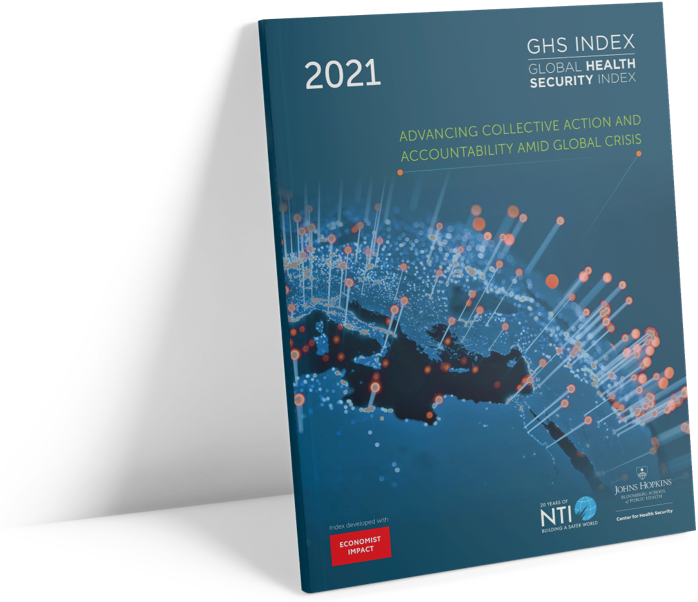Welcome to theGlobal Health Security Index
The GHS Index measures the capacities of 195 countries to prepare for epidemics and pandemics. All countries remain dangerously unprepared for future epidemic and pandemic threats, including threats potentially more devastating than COVID-19.
Read the 2021 report findings and recommendations, explore the data, view the country rankings, and learn more about the GHS Index.
0
Findings
The GHS Index assesses countries’ health security and capabilities across six categories and 37 indicators. The findings are drawn from open source information that answered 171 questions across the categories.
-
Although many countries were able to quickly develop capacities to address COVID-19, all countries remain dangerously unprepared for meeting future epidemic and pandemic threats. A great opportunity exists, however, to make new capacities more durable to further long-term gains in preparedness.
The Data:
- The average country score in 2021 was 38.9 out of 100, which is essentially unchanged from 2019. Looking at overall GHS Index scores, no country scored in the top tier5 of the GHS Index, signaling that significant gaps exist for all countries and across all GHS Index categories and reinforcing that preparedness remains fundamentally weak at all country income levels.
Read more on the Report & Model page.
-
Most countries, including high-income nations, have not made dedicated financial investments in strengthening epidemic or pandemic preparedness.
The Data:
- One hundred fifty-five out of 195 countries have not allocated national funds within the past three years to improve their capacity to address epidemic threats; among those who have, only two low-income countries have evidence of allocating funds. Ninety countries have not fulfilled their full financial contribution to the WHO; 14 of those countries are high-income countries.
Read more on the Report & Model page.
-
Most countries saw little or no improvement in maintaining a robust, capable, and accessible health system for outbreak detection and response.
The Data:
- Seventy percent of countries show insufficient health capacity in clinics, hospitals, and community health centers, including human resources and facilities capacity. Only 25% of countries, or 49, have published an updated health workforce strategy over the past five years to address staffing shortages.
Read more on the Report & Model page.
-
Political and security risks have increased in nearly all countries, and those with the fewest resources have the highest risk and greatest preparedness gaps.
The Data:
- Trust in government, which has been a key factor associated with success in countries’ responses to COVID-19, is low and decreasing. One hundred sixty-one countries have low to moderate levels of public confidence in their government. Only 16 countries score in the top tier for government effectiveness.
Read more on the Report & Model page.
-
Countries are continuing to neglect the preparedness needs of vulnerable populations, which exacerbates the impact of health security emergencies.
The Data:
- Only 33 countries have an overarching emergency preparedness and response plan in place that includes considerations for vulnerable populations. One hundred forty-nine of 195 countries do not identify how risk communication messages will reach populations and sectors with different communication needs related to language, location, and media reach.
Read more on the Report & Model page.
-
Countries are not prepared to prevent globally catastrophic biological events that could cause damage on a larger scale than COVID-19.
The Data:
- Nearly two-thirds, or 126, countries have not published and implemented an overarching national public health emergency response plan for diseases with epidemic or pandemic potential. Seventy-three percent of countries do not have the ability to provide expedited approval for medical countermeasures, such as vaccines and antiviral drugs, during a public health emergency. One hundred seventy-eight countries score less than 50 out of 100 points for whole-of-government biosecurity systems, training, personnel vetting, transport of infectious substances, and cross-border transfer and screening.
Read more on the Report & Model page.
38.9
28.4
